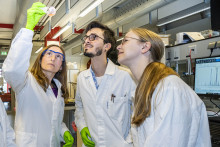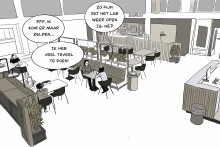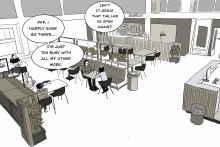Julieta Paez, Assistant Professor at the Department of Developmental BioEngineering and the TechMed Centre for Biomedical Research, is one of the successful scientists working at Twente’s new Molecules Centre. One of her research projects involves the development of better cell culture systems. ‘There is a worldwide shortage of organs and tissues for transplantation’, she says. ‘With an ageing population, and the associated increase in diseases, there will be an even larger demand for organs to replace or repair diseased and damaged tissues. Thus, there is a need for new synthetic materials where cells, tissues and even organs can be grown more efficiently.’ With a multidisciplinary team of scientists, she is developing soft materials, known as hydrogels. They mimic the so-called extra-cellular matrix, that embeds and surrounds cells in living tissue. ‘This extra-cellular matrix consists of a firm network of proteins surrounded by liquid’, Paez explains. ‘Cells are dependent on this matrix for growth and survival. They attach to the network, while the liquid provides the cells with nutrients and removes waste products.’
Challenging task
The long-term goal of Paez and her team is to make synthetic matrices that act like natural ones, improving current cell cultures and eventually grow tissues in a laboratory environment. However, it is complicated to make a fully functional artificial matrix that is suitable to culture different tissue types. It requires in-depth knowledge about the natural versions. A challenging task, since matrices come in many different types and they influence tissue properties. For example, the mechanical properties of a tissue, like ‘stiffness’ or ‘softness’, depend on the consistency of the matrix. Cartilage is much stiffer than, for example, kidney. This is determined by the network composition and density: a more dense, fine-meshed network results in a firmer tissue than a more open network, containing more fluid. To make things even more complicated, the matrix is not static, but very dynamic: its composition changes over time, while it communicates with the embedded cells, steering them into different paths, for example, keeping them healthy and growing, but it may also be a factor causing diseased cells. Paez: ‘We want to understand how cells communicate with the matrix. This helps us designing a well-functioning artificial version, but may also provide clues why certain diseases occur: a changed or disrupted communication between cells and matrix may result in certain diseases. Gaining a better understanding of these processes may also help us in developing potential treatments.’

Inspired by nature
To make an artificial matrix, Paez didn’t use the protein chains that are naturally present. Instead, she successfully applied long synthetic molecules, polymers, similar to the building blocks of plastic. She mixed these polymers with cell culturing liquid and a suspension of living cells. ‘At this stage, the mixture is still liquid, with only lose polymers, that don’t form a network’, Paez says. ‘It doesn’t resemble a supporting, natural matrix yet.’ To form a solid network, these polymers should form bonds, cross-links, with each other. But since also living cells are present in the liquid mix, it should be a mild process, that wouldn’t affect the living cells. To achieve this, Paez was inspired by nature. She used a chemical trick used by fireflies. ‘Fireflies are known for the green-yellow light they emit during the night by oxidizing a chemical called luciferin’, she explains. ‘They make this luciferin by merging two molecules: these form new bonds and attach to each other. We used a similar concept to bond the separate polymers in our basic mixture, so they could form a network.’ The result was a polymer network, inspired by a natural process, where the living cells were entrapped without being damaged.
Optimal performance
However, the artificial matrix still was static, consisting of a polymer network surrounded by liquid, with little changes possible. For an optimal performance, the network should become a more dynamic system, recognized by the living cells, that could interact with it and change it when needed. ‘To grow and thrive, the cells need space and the network should support this by allowing the cells more room where and when needed’, Paez explains. ‘So, we needed to include biodegradable parts in the static network to make it more dynamic and flexible: the cells were able to break down the bonds of the network, for example, to create room for growth.’ To achieve this, she included biodegradable bonds inside the network: the living cells could easily cut these bonds using specialized enzymes.

Common goal
Paez’s and her team are now taking this artificial matrix to the next level by fabricating ‘smart materials’ that have more advanced capabilities like, for example self-healing properties. She attributes the success of her research to her multidisciplinary team within the Molecules Centre: ‘Thanks to the collaboration of scientists from different disciplines, we manage to pull it off.’ By complementing their different fields of expertise, this research has shown how the team has worked successfully towards a common goal: a better understanding on how biological molecules and cells work and how they can be used to solve medical challenges and benefit society. Paez takes quite some inspiration from nature, but also from the people that surround her. ‘Interdisciplinary collaboration and team work with open discussions with colleagues within the Molecules Centre inspire me and are key to meet my research goals. This often offers new perspectives for our research and helps us to better understand the complexity of molecules that surround us’, she says. ‘So, the collaborations with the Molecules Centre and with the TechMed Centre are vital to achieve solutions. This way we can produce scientific knowledge that will have a bigger impact. And it is also a lot of fun.’









